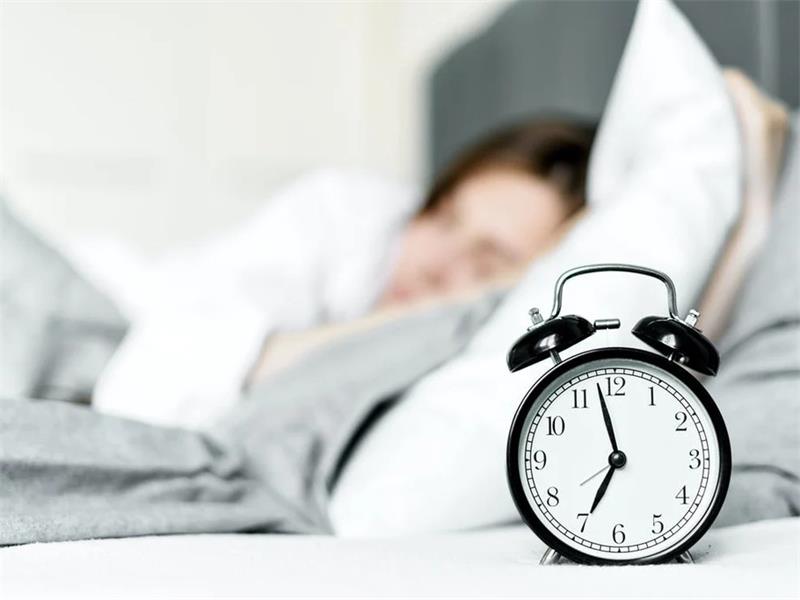Contents
- 1 The Importance of Sleep
- 2 The Benefits of a Healthy Sleep Routine
- 3 Developing Healthy Sleep Habits
- 4 Understanding Sleep
- 5 Creating a Sleep-Conducive Environment
- 6 Establishing a Bedtime Routine
- 7 Managing Technology Use Before Bedtime
- 8 Addressing Common Sleep Disorders
- 9 Incorporating Relaxation Techniques
- 10 Conclusion
The Importance of Sleep
Sleep is an essential part of maintaining overall health and well-being. Not only does it allow our bodies to rest and recharge, but it is also important for cognitive function, emotional regulation, and physical performance.
Despite this, many people neglect the importance of getting enough quality sleep each night. Research has shown that lack of sleep can have negative effects on our physical health, including an increased risk for obesity, diabetes, heart disease, and stroke.
It can also impact mental health by increasing symptoms of anxiety and depression. Additionally, poor sleep habits can lead to decreased productivity at work or school and a general feeling of fatigue throughout the day.
The Benefits of a Healthy Sleep Routine
Developing a healthy sleep routine can have numerous benefits on overall health and well-being. By establishing consistent sleep patterns, individuals may experience improved mood regulation, enhanced memory consolidation and learning capabilities, as well as better physical performance.
A healthy sleep routine involves not only getting enough hours of rest but also maintaining a consistent schedule that allows your body to follow its natural circadian rhythm. This means going to bed at the same time each night and waking up at the same time each morning.
Developing Healthy Sleep Habits
Developing healthy sleep habits often involves making lifestyle changes that promote better quality rest. One way you can improve your sleep routine is by creating a comfortable sleeping environment.
This may include keeping your bedroom cool (around 60-67 degrees Fahrenheit), reducing noise levels with earplugs or white noise machines, and investing in comfortable bedding such as supportive pillows or cozy blankets. In addition to creating a conducive environment for sleeping soundly through the night, developing healthy habits around technology use is equally important for improving your quality of rest.
Experts suggest avoiding electronic devices such as smartphones or laptops before bedtime since they emit blue light that suppresses melatonin production – the hormone responsible for promoting relaxation and restful sleep. Developing a healthy sleep routine has numerous benefits for overall health and well-being.
It is important to prioritize getting enough quality rest each night by making lifestyle changes that promote relaxation and uninterrupted sleep. So be mindful of your sleeping habits, create a comfortable environment, limit technology use before bedtime, and establish a consistent sleep schedule to improve your overall health.
Understanding Sleep
Sleep is a crucial aspect of our lives that affects our overall health and well-being. Understanding the different stages of sleep can help us identify the areas we need to work on to improve our sleeping patterns. There are two types of sleep: non-rapid eye movement (NREM) and rapid eye movement (REM).
During NREM, there are four different stages that occur, ranging from light sleep in stage one to deep sleep in stage four. Each stage lasts for 90 minutes before cycling back through all four stages again.
Deep sleep, which happens during stages three and four, is particularly important as it’s when the body repairs itself. REM occurs about 90 minutes after you fall asleep and usually lasts for around 10 minutes.
During this phase, the brain is active while the body remains still. REM is when dreams occur, and it’s essential for memory consolidation.
The circadian rhythm
The circadian rhythm is a biological process that regulates our sleep-wake cycle over a 24-hour period. It’s affected by external factors such as light exposure, temperature changes, and physical activity levels during the day.
One of the main hormones involved in regulating our circadian rhythm is melatonin – a hormone that makes us feel sleepy at night-time. Melatonin production increases when it gets dark outside and decreases when there’s light.
Disruption of your circadian rhythm can affect your ability to fall asleep or stay asleep throughout the night. Studies have found that people who work night shifts or travel across time zones frequently tend to have disrupted circadian rhythms.
It’s important to maintain a consistent wake-up time each day as this helps regulate your circadian rhythm more effectively. Implementing little habits like getting up at the same time every day could significantly improve your quality of sleep over time!
Creating a Sleep-Conducive Environment
The Ideal Bedroom Environment for Better Sleep
When it comes to getting a good night’s sleep, the environment in which you sleep can play a significant role. Ideally, your bedroom should be cool, quiet, and dark.
This means keeping the temperature between 60-67 degrees Fahrenheit, using earplugs or white noise machines to block out any unwanted sounds, and investing in blackout curtains or shades to keep the room dark. Additionally, the mattress and pillows you use can also impact your sleep quality.
It’s important to invest in a comfortable mattress that provides adequate support for your body type and sleeping position. Similarly, choosing pillows that properly support your neck and head can help prevent pain and discomfort during the night.
Creating a Relaxing Atmosphere in Your Bedroom
In addition to creating an ideal sleeping environment, incorporating elements of relaxation into your bedroom décor can also promote better sleep. Consider using calming colors such as blues or greens on your walls or bedding to create a peaceful ambiance.
Other ways to create a relaxing atmosphere include adding plants (which can improve air quality), incorporating soft lighting options such as bedside lamps or candles (avoiding bright overhead lighting), and minimizing clutter in the space. Another important aspect of promoting relaxation in the bedroom is keeping work-related items such as laptops or paperwork out of sight.
By creating a physical separation between work and sleep spaces within your home, you’ll be able to more effectively unwind at night before bed. By focusing on creating an ideal sleeping environment that promotes relaxation rather than stimulation, you’ll find yourself feeling more rested come morning.
Establishing a Bedtime Routine
Developing a consistent bedtime routine is one of the most effective ways to ensure you get enough sleep and wake up feeling refreshed. A routine signals to your brain that it’s time to prepare for sleep, making it easier to fall asleep and stay asleep throughout the night. In this section, we’ll discuss the benefits of having a consistent bedtime routine and provide examples of activities that can be incorporated into your bedtime routine.
The Benefits of Having a Consistent Bedtime Routine
Having a consistent bedtime routine offers many benefits. First and foremost, it helps regulate your body’s internal clock, also known as the circadian rhythm.
This allows you to fall asleep more easily at night and wake up feeling rested in the morning. Additionally, following a routine can reduce stress levels since it provides structure and predictability in your day-to-day life.
Furthermore, having a set schedule ensures that you allow yourself enough time for sleep each night. By prioritizing sleep through developing a bedtime routine, you’re investing in your overall health and well-being since getting enough rest supports mood regulation, cognitive function, and immune system function.
Activities to Incorporate into Your Bedtime Routine
The key to establishing an effective bedtime routine is finding activities that help relax your mind and body before bed. Below are some examples of activities that can be incorporated into your own personalized bedtime ritual:
1) Take a warm bath or shower: A warm bath or shower before bed helps relax tense muscles while also raising core body temperature which can help induce drowsiness. 2) Read or listen to calming music: Reading or listening to calming music before bed is an effective way to wind down from the day’s activities while minimizing exposure to screens which could disrupt natural sleep cycles.
3) Write in a journal: Journaling before bed is an opportunity for self-reflection and a great way to release any troubling thoughts or worries from the day. 4) Meditate: Practicing meditation before bed can help reduce stress levels, lower heart rate, and quiet overactive minds.
Finding what works for you is key when establishing a bedtime routine. By incorporating these activities into your evening ritual, you’ll be well on your way to better sleep hygiene and improved overall health.
Managing Technology Use Before Bedtime
How Technology Use Can Disrupt Sleep
In today’s world, technology is an essential part of our daily lives. Many people use their smartphones or tablets in bed to scroll through social media, watch videos, or read articles before going to sleep. However, this can be harmful to one’s sleep quality.
The blue light emitted by electronic devices can disrupt the body’s melatonin production, making it harder to fall asleep and stay asleep. Additionally, the stimulating content of social media and other sources can keep the mind active and prevent relaxation.
Tips on How to Limit Technology Use Before Bedtime
While it may seem challenging to break the habit of using technology before bed, there are several strategies that can help make it easier. Firstly, set a cut-off time for all electronic devices at least an hour before bedtime.
This will give your mind enough time to unwind and prepare for sleep without any distractions from technology. Secondly, try replacing your device usage with calming activities such as reading a book or taking a warm bath.
These activities will help you relax and ease into sleep. Consider using blue light-blocking glasses or apps that filter out blue light on your phone or tablet during nighttime hours.
This reduces exposure to blue light that disrupts melatonin production in the body. By following these tips and limiting technology use before bed, you’ll create a more conducive environment for restful sleep that will improve overall health and well-being over time.
Addressing Common Sleep Disorders
The Troubles of Insomnia
Insomnia is a common sleep disorder that affects millions of people worldwide. It can be characterized by difficulty falling asleep, staying asleep, or waking up too early and not being able to fall back asleep. Insomnia can be caused by many factors, including stress, anxiety, depression, and medical conditions.
The good news is that there are treatment options available for those who suffer from insomnia. One of the most effective ways to treat insomnia is through cognitive-behavioral therapy (CBT).
CBT focuses on changing the negative thoughts and behaviors that contribute to insomnia and replacing them with positive ones. Another option for treating insomnia is medication.
There are several types of prescription medications available that can help improve sleep quality and quantity. However, it’s important to talk to a healthcare professional before taking any medication.
Sleep Apnea: The Silent Killer
Sleep apnea is a serious sleep disorder characterized by pauses in breathing during sleep. These pauses can last anywhere from a few seconds to several minutes and can occur multiple times throughout the night. Sleep apnea can cause fatigue, high blood pressure, heart disease, and even stroke if left untreated.
The most common form of treatment for sleep apnea is continuous positive airway pressure (CPAP) therapy. CPAP therapy involves wearing a mask over the nose or nose and mouth while sleeping.
The mask delivers pressurized air into the throat to keep the airway open during sleep. Other treatment options include lifestyle changes such as weight loss or positional therapy where one sleeps in positions that prevent blockages in breathing passages.
The Restless Leg Syndrome Conundrum
Restless leg syndrome (RLS) is another sleep disorder that affects millions of people worldwide. It’s characterized by an uncontrollable urge to move one’s legs, especially at night. This can cause difficulty falling asleep and disrupt sleep throughout the night.
RLS can be caused by underlying medical conditions such as iron deficiency anemia or kidney failure. One of the most effective treatments for RLS is medication.
There are several prescription medications available that can help reduce symptoms and improve sleep quality. Lifestyle changes such as regular exercise and avoiding caffeine and alcohol before bedtime may also help alleviate symptoms of RLS.
It’s important to address common sleep disorders to ensure a healthy sleep routine. Insomnia, sleep apnea, and restless leg syndrome are just a few examples of disorders that can disrupt one’s rest.
Treatment options for each disorder include lifestyle changes, cognitive-behavioral therapy (CBT), medication, or a combination thereof. Consultation with a healthcare professional is recommended for the diagnosis and treatment of any potential sleep disorder one suspects they might have.
Incorporating Relaxation Techniques
Unwind with Meditation
Meditation is a relaxation technique that has been used for centuries to calm the mind and reduce stress levels. It involves focusing on your breath or a specific object, and letting go of thoughts that come to mind. Incorporating meditation into your bedtime routine can help you clear your mind, relax, and fall asleep faster.
To start meditating, find a quiet space where you won’t be disturbed. Sit or lie down in a comfortable position, close your eyes, and focus on your breath.
If thoughts come to mind, acknowledge them but then let them go without dwelling on them. Start with just a few minutes at first and gradually increase the duration as you become more comfortable with the practice.
Breathe Deeply for Better Sleep
Deep breathing is another relaxation technique that can help you unwind before bed. It involves taking long, slow breaths in through your nose and out through your mouth. This type of breathing slows down your heart rate and lowers blood pressure, which helps promote relaxation.
To practice deep breathing before bed, sit or lie down in a comfortable position and close your eyes. Place one hand on your chest and the other hand on your belly.
Take a deep breath through your nose while counting to four, hold it for two seconds, then slowly exhale through your mouth while counting to six. Repeat this cycle for several minutes until you feel relaxed.
Yoga for Sleep
Yoga is an ancient practice that combines physical poses with deep breathing techniques to promote relaxation and reduce stress levels. It’s also been shown to improve sleep quality by reducing anxiety levels. Incorporating some simple yoga poses into your bedtime routine can help relax both body and mind before sleep.
Some recommended poses include Child’s Pose (balasana), Legs Up the Wall Pose (viparita karani), and Corpse Pose (savasana). Practice these poses for a few minutes before bed to promote relaxation and better sleep.
Conclusion
Getting enough sleep is a vital component of overall well-being, and developing a healthy sleep routine is an effective way to improve the quantity and quality of your sleep. The benefits of good sleep cannot be overstated; it can help boost your immune system, improve memory and concentration, reduce stress levels, and even regulate your appetite. By incorporating the tips outlined in this article, you can enhance your sleep quality and enjoy improved health.
However, it’s important to bear in mind that developing a healthy sleep routine is not a one-time event but rather an ongoing process. It might take some time to get used to new habits or find what works best for you.
Be patient with yourself as you make changes towards better sleep hygiene. Remember that good self-care also involves avoiding harmful habits such as excessive caffeine intake or screen time before bedtime.
If you struggle with insomnia or another sleep disorder, consider talking to your doctor about effective treatment options that can help improve your sleep quality. Getting better rest requires intentionality and discipline but it’s worth it!
By making small changes towards better sleep hygiene consistently over time, we can all enjoy greater health benefits and improved overall well-being. Take the first step today towards improving your sleeping habits by incorporating some of the tips mentioned above into your daily routine!













